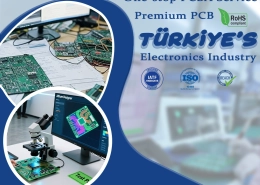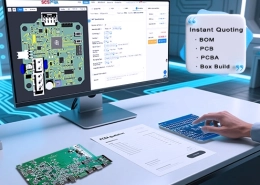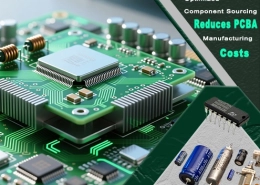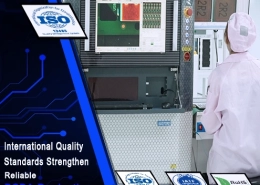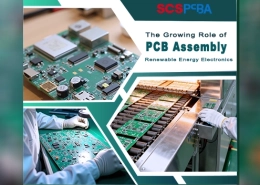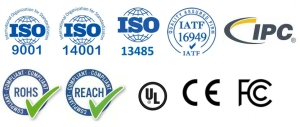How Automotive Electronics PCB Assembly Drives Smart Vehicle Development
Smart vehicles rely heavily on automotive electronics PCB assembly to enable functions such as autonomous driving, infotainment, and safety management. The automotive circuit board manufacturing serves as the brain of these systems, connecting sensors, control units, and processors into a unified intelligent network.
At the heart of automotive electronic systems, circuit boards manage power distribution, signal integrity, and heat dissipation — crucial factors for vehicle reliability and performance. From ADAS (Advanced Driver Assistance Systems) to electric drive modules, printed circuit board production technology defines how efficiently data and energy flow through a smart vehicle.
Advanced PCB Technologies for High-Frequency and Reliability Requirements
Automotive environments demand high-frequency circuit boards and high-reliability PCB designs capable of enduring extreme temperatures, vibration, and electromagnetic interference.
Key process points are as follows:
1. Material Selection and Substrate Treatment
High-Frequency Substrate:
- Millimeter-wave radar boards utilize a PTFE hybrid process (such as Rogers RO4835+FR4);
- The dielectric constant must be controlled within 2.55±0.05@10GHz;
- The copper foil roughness must be ≤0.8μm to minimize signal loss.
High-Temperature Design:
- PCBs for engine compartments require a high-Tg substrate (Tg ≥ 170°C);
- aluminum substrate with a thermal conductivity ≥ 8W/(m·K);
- a copper thickness of 70-105μm to handle high current heating.
Surface Treatment:
- High-frequency circuits require a gold plating layer with a thickness of 0.1-0.2μm and a contact resistance of <20mΩ;
- For standard signals, OSP coating can be used to reduce costs by 40%.
2. Precision PCB Board Fabrication Process
Lamination Technology:
- Multi-layer PCBs, such as 8-layer boards, require a vacuum hot press at 185°C for 90 minutes. Resin flow deviation must be ≤5%, and inter-layer alignment accuracy must reach micron levels (e.g., a 20-layer board with line widths of only tens of microns).
Drilling and Metallization:
- 0.1mm micro-holes are laser-processed, with mechanical drilling tolerances ≤15μm.
- Hole wall copper thickness is ≥25μm, and pulse plating technology achieves 90% uniformity.
Etching Accuracy:
- Outer layer circuits utilize laser direct writing technology (±3μm).
- Inner layer circuits undergo UV lithography followed by microscopic scanning and inspection (800 points/hour).
3. Reliability-Enhanced PCB Board Manufacturing Process
Vibration-Resistant Design:
- Reinforced through-holes utilize thick-wall plating (copper thickness ≥ 25μm);
- Rounded corners (radius ≥ 0.1mm), and have passed a 1 million-cycle vibration test.
Corrosion-Resistant Treatment:
- Ultra-thick solder mask (>40μm) + nano-coating, passed a 1000-hour acid salt spray test.
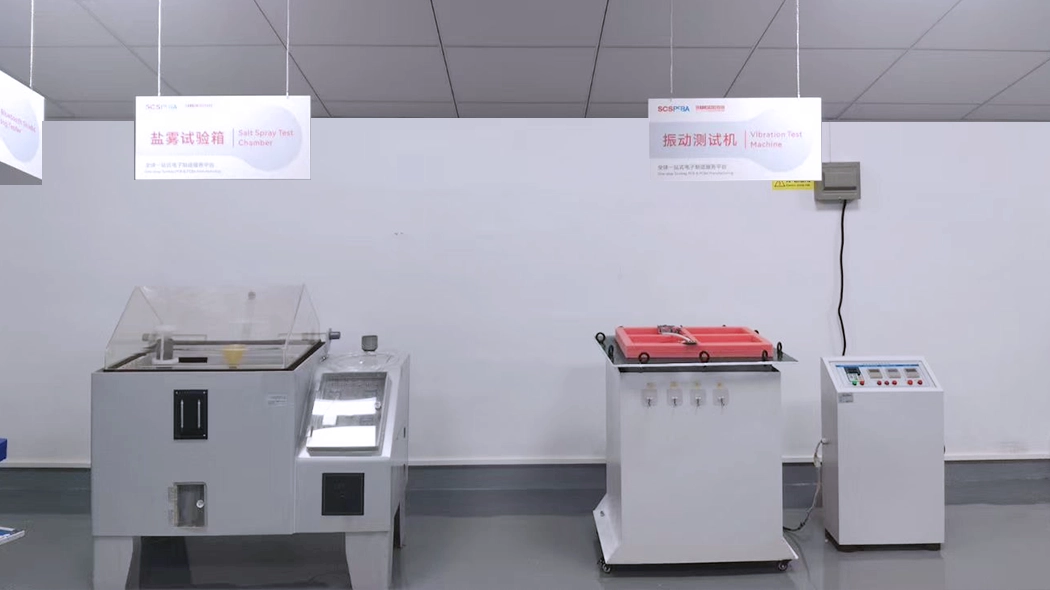
Lead-Free Soldering:
- SAC305 solder with a melting point of 217°C, combined with gold-plated pads to prevent high-temperature oxidation.
4. Quality Inspection Standards
Defect Control:
- Automotive-grade PCBs have a defect tolerance of ≤0.1ppm and must pass AOI, AXI, and flying probe inspections.
Accelerated Aging Testing:
- Qualified for extreme environments such as high temperature (150°C), high humidity, and vibration, ensuring service life.
Typical Automotive Applications of Printed Circuit Assembly
1. ADAS Systems (Advanced Driver Assistance Systems)
ADAS relies on high-density automotive PCB assemblies to manage radar, LiDAR, and camera signals in real time. These systems require RF and high-frequency PCBs to process large volumes of sensor data with precision and low latency.
Typical applications include:
- Millimeter-wave radar/lidar
Using a PTFE hybrid laminate (such as Rogers RO4835), the dielectric constant is stabilized at 2.55 ± 0.05 @ 10 GHz, ensuring 77 GHz radar signal transmission loss of <0.5 dB/in. - Vision processing unit
Multi-layer HDI PCB boards (8-12 layers) integrate high-performance SoC chips. A buried resistor process controls impedance tolerance to ±5%, meeting image processing latency requirements of <10 ms. - Redundant design
Critical control circuits utilize a two-layer PCB layout, and AEC-Q100-qualified components achieve failover times of <50 μs.
2. Powertrain and Battery Management Modules
New energy vehicle powertrains place stringent demands on PCB manufacturing techniques for high-temperature resistance and high-current carrying capacity:
- BMS (Battery Management System)
An aluminum PCB substrate (thermal conductivity ≥ 8W/(m·K)) combined with a thick copper process (copper thickness 70-105μm) achieves battery pack voltage monitoring accuracy of ±1mV and temperature sampling error of ±0.5°C. - Motor Controller
A high-Tg FR4 substrate (Tg ≥ 170°C) is used, and a liquid cooling structure keeps the IGBT module junction temperature below 125°C, supporting a continuous 200A output current. - Protective Design
The conformal coating (thickness 40-60μm) has passed a 1000-hour salt spray test and ensures insulation resistance >100MΩ in humid environments.
3. Infotainment and Connectivity Units
Modern infotainment systems integrate intelligent PCB circuit board designs that support Bluetooth, Wi-Fi, GPS, and 5G connectivity. Reliable PCB assembly and manufacturing ensure seamless communication between the driver and the vehicle’s digital ecosystem.
- 5G Internet of Vehicles Module
High-frequency boards (such as M6-grade FR4) support the 3.5 GHz frequency band, and EMI shielding keeps radiated interference within Class B standards. - Multi-screen Interaction System
Rigid-flexible printed circuit boards (FPC + rigid board) enable flexible connections between the central control screen and the instrument panel, with a flex lifespan exceeding 100,000 cycles.
4. Intelligent Driving System
- Sensor Module
Millimeter-wave radar, LiDAR, and other systems utilize rigid-flex boards, balancing high-frequency signal transmission with temperature resistance. - Autonomous Driving Computing Platform
Multi-layer HDI boards carry AI chips, requiring optimized heat dissipation and electromagnetic compatibility.
5. In-Vehicle Electronics
- Infotainment System
Center control screens, HUDs, and other systems rely on high-density PCBs for audio and video processing and interactive functions. - Air Conditioning Control Module
Controlling temperature and humidity parameters through PCB board layout requires high-temperature-resistant materials (such as aluminum substrates).
6. Safety and Assistance Systems
- Airbag Controller
Red solder mask PCB is used to withstand extreme temperatures and chemical corrosion. - ABS/ESP System
Wheel speed sensor signals are processed in real time on the PCB, requiring a vibration-resistant design.
7. New Energy Three-Electric System
- Charging Interface Module
Rigid-flex PCB replaces wiring harnesses, improving electrolyte protection. - Wireless Charging Module
High-frequency PCB optimizes energy transmission efficiency, requiring low dielectric loss materials.
Common Technical Requirements for Automotive Electronics PCB Fabrication and Assembly
1. Reliability Verification
All automotive-grade PCBs must pass -40°C to 125°C temperature cycling tests, 50G mechanical shock tests, and 15-year accelerated aging.
2. Electromagnetic Compatibility
The spacing between power and signal layers must be ≥ 0.2mm. Key signal lines must be ground-wrapped. Pass ISO 11452-2 radiated immunity testing.
3. Printed Circuit Board Manufacturing Process
Laser microvias (aperture diameter ≤ 0.1mm) and pulse plating technology (via copper uniformity > 90%) meet high-density interconnect requirements.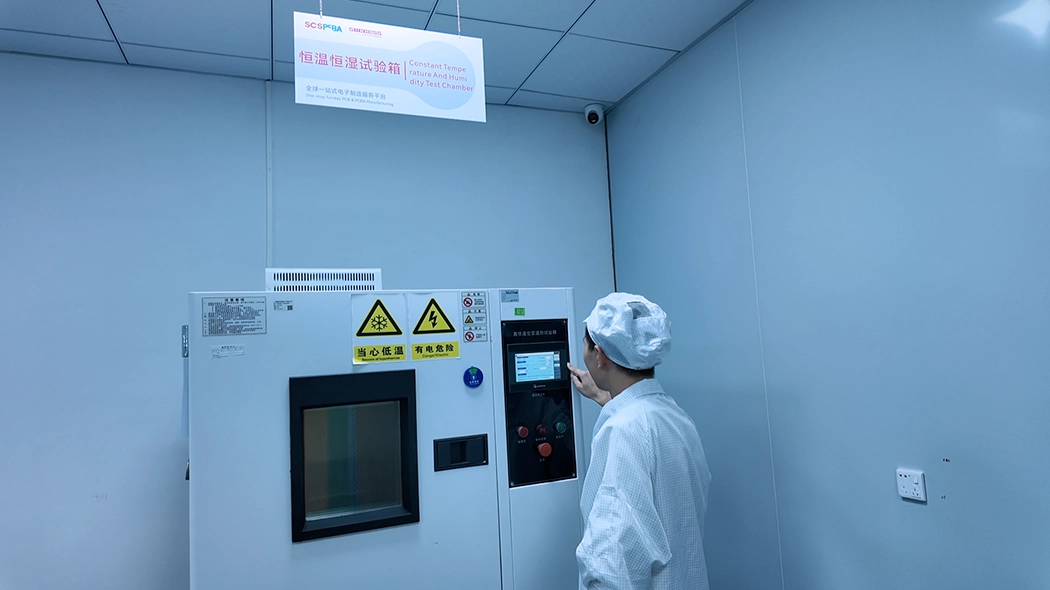
SCSPCBA’s Strength in Automotive PCB and Assembly Manufacturing
At SCSPCBA, we deliver world-class automotive PCB assembly solutions that meet the stringent performance, safety, and reliability standards required by modern smart vehicles. With over a decade of experience in automotive PCBA manufacturing, our facilities integrate intelligent production, strict process control, and comprehensive quality validation to ensure every board performs flawlessly on the road.
1. Advanced PCB Manufacturing and Assembly Production Capabilities
Our automotive printed circuit assembly lines are equipped with fully automated SMT and DIP assembly systems capable of handling fine-pitch components and multilayer boards. Each production line features:
- High-precision SMT placement with ±0.03mm accuracy.
- Reflow soldering with nitrogen protection to minimize oxidation and solder voids.
- Automated Optical Inspection (AOI) and X-ray inspection for hidden solder joints.
- Selective wave soldering optimized for automotive connectors and power circuits.
These advanced systems allow SCSPCBA to assemble high-density automotive PCBs for ADAS modules, EV power systems, infotainment controls, and radar sensors — ensuring both electrical and mechanical reliability.
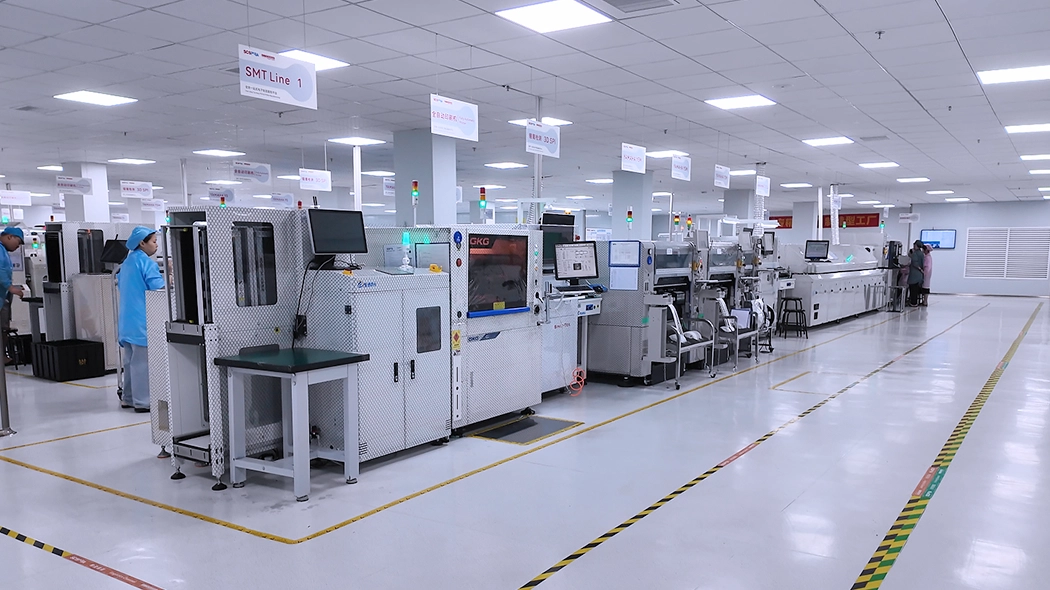
2. Commitment to Automotive-Grade Quality
Quality and reliability are at the heart of our automotive PCBA process. SCSPCBA operates under IATF 16949, ISO 9001, and IPC-A-610 Class 3 standards to ensure every board meets automotive-grade durability and traceability.
Each batch undergoes multi-level inspection including:
- ICT and FCT testing to verify functional integrity.
- Thermal cycling and vibration simulation to validate reliability in harsh environments.
- Conformal coating and potting options to enhance moisture and heat resistance.
Our traceability system records material lot numbers, process parameters, and operator data — enabling full product tracking from PCB fabrication and assembly to box build assembly.
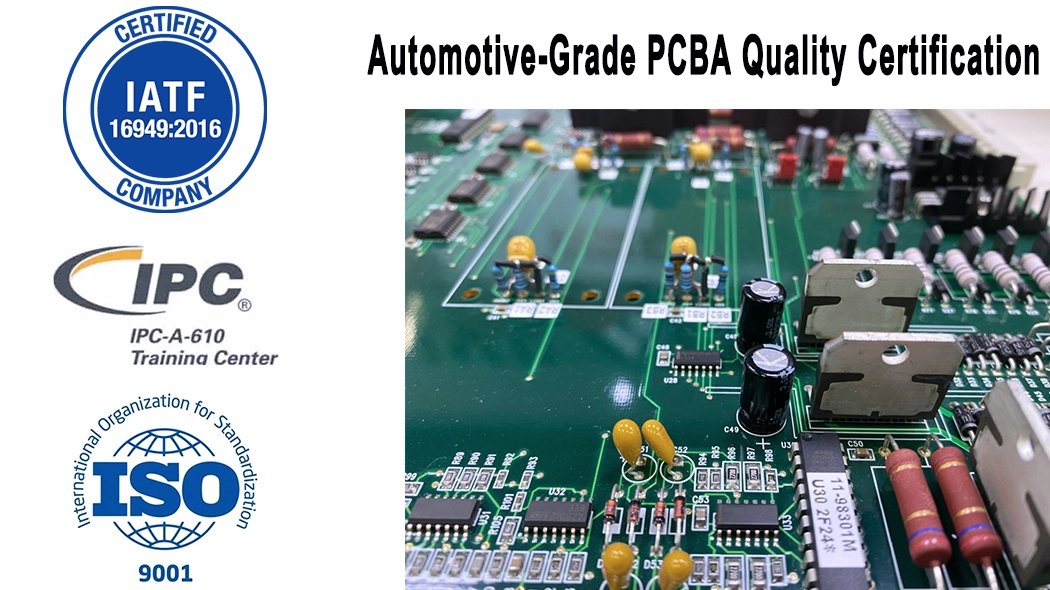
3. Expertise in High-Frequency and Power Electronics
SCSPCBA’s R&D and engineering teams specialize in high-frequency PCB design and power electronics assembly, supporting radar and 5G communication modules, motor control boards, and energy conversion units. We utilize advanced materials such as Rogers, Isola, and Taconic laminates, paired with controlled impedance routing, copper via filling, and ENIG surface finishes to ensure signal stability and long-term performance.
Our experience extends to automotive applications like ADAS, BMS, ECU, and LED lighting modules, all requiring superior EMC performance and high-temperature endurance.
4. Trusted by Global Automotive Partners
Through years of collaboration, SCSPCBA has established strong partnerships with automotive OEMs and Tier 1 suppliers across Asia, Europe, and North America. Our clients rely on us for prototype development, volume production, and rapid technical support for automotive PCBA projects.
Whether it’s an EV battery management system, a vehicle radar module, or a central control PCB assembly, our team ensures every solution aligns with the client’s performance targets, compliance requirements, and cost expectations.
Looking Ahead – Enabling the Future of Intelligent Mobility
The automotive industry is accelerating toward a future defined by electrification, automation, and seamless connectivity. From autonomous driving systems to EV power modules and smart cockpit electronics, every innovation depends on the reliability and performance of automotive PCB assemblies that form the electronic backbone of modern vehicles.
At SCSPCBA, our mission is to empower the next generation of smart vehicle electronics through precision manufacturing, continuous process improvement, and full lifecycle support — from concept and circuit board prototyping to mass PCB board printer production and pcb board testing.
Whether you are developing an ADAS control board, BMS module, or in-vehicle infotainment system, our engineering experts can provide end-to-end solutions that meet your technical, quality, and cost goals.
👉 Ready to drive your innovation forward?
Partner with SCSPCBA, your trusted automotive PCB assembly manufacturer, and transform your smart mobility ideas into reliable, production-ready solutions.
Contact us today to discuss your next automotive PCBA project.

